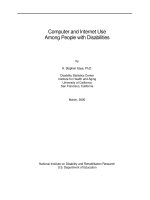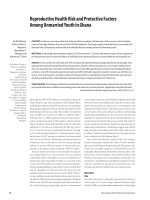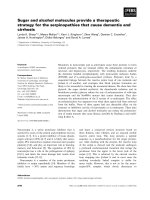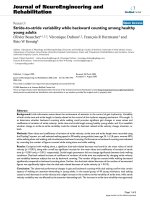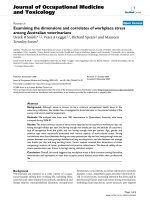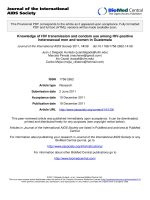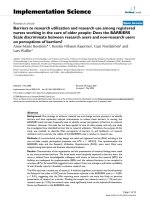Alcohol consumption and protective behavioural strategy use among Australian young adults
Bạn đang xem bản rút gọn của tài liệu. Xem và tải ngay bản đầy đủ của tài liệu tại đây (350.97 KB, 16 trang )
International Journal of Adolescence and Youth
ISSN: 0267-3843 (Print) 2164-4527 (Online) Journal homepage: />
Alcohol consumption and protective behavioural
strategy use among Australian young adults
Fiona M. Crawford-Williams, Rachel M. Roberts & David Watts
To cite this article: Fiona M. Crawford-Williams, Rachel M. Roberts & David Watts
(2016) Alcohol consumption and protective behavioural strategy use among Australian
young adults, International Journal of Adolescence and Youth, 21:1, 119-133, DOI:
10.1080/02673843.2013.831363
To link to this article: />
© 2013 Taylor & Francis
Published online: 17 Dec 2013.
Submit your article to this journal
Article views: 545
View related articles
View Crossmark data
Full Terms & Conditions of access and use can be found at
/>Download by: [203.128.244.130]
Date: 15 March 2016, At: 02:03
International Journal of Adolescence and Youth, 2016
Vol. 21, No. 1, 119–133, />
Alcohol consumption and protective behavioural strategy use among
Australian young adults
Fiona M. Crawford-Williamsa*, Rachel M. Robertsb and David Wattsc
a
School of Nursing and Midwifery, University of South Australia, Frome Street, Adelaide SA 5001,
Australia; bSchool of Psychology, University of Adelaide, Adelaide, Australia; cDrug Policy and
Population Health Division, Drug and Alcohol Services SA, Adelaide, Australia
Downloaded by [203.128.244.130] at 02:03 15 March 2016
(Received 5 December 2012; final version received 31 July 2013)
This study examines the use of safeguards or protective behaviours by young adults to
reduce the harm and negative consequences associated with excessive alcohol
consumption. Participants were 210 Australian university students. Participants
completed an online questionnaire which focused on their alcohol consumption and
engagement in protective behaviours. Results indicate that all participants who
consumed alcohol engaged in protective behaviours at some level, with females
reporting similar levels of these behaviours to males. Protective strategy use was
related to less negative consequences of alcohol use. These findings suggest that the
promotion of harm reduction strategies is needed to complement prevention
programmes which aim to reduce the consumption of alcohol.
Keywords: alcohol; public health; risk behaviour; youth; students
Introduction
Alcohol consumption in Australia
Alcohol is an important feature of most modern Western societies, and since European
settlement, alcohol has played an important role in the social, economic and political
culture of Australia. Alcohol consumption is widely accepted and has become an integral
part of Western culture; in particular, it plays an important role in the lives of young adults
as they negotiate their entry into adulthood (Roche et al., 2007). However, it is only in
fairly recent times that a culture of binge drinking has become truly noticeable through
worldwide media attention (Alcohol Education and Rehabilitation Foundation [AERF],
2007; Australian Medical Association, 2008; Department of Health and Ageing, 2008;
Martinic & Measham, 2008; Roche et al., 2007; West, 2008).
Today, alcohol use and alcohol misuse are a major public health issue in Australia with
excessive alcohol consumption being a leading cause of motor vehicle accidents,
emergency hospitalisations, physical and sexual assaults, injuries and death (Roche et al.,
2007). Alcohol is second only to tobacco as the largest cause of drug-related deaths and
hospitalisations in Australia, contributing to 7% of all male deaths and 4% of all female
deaths (Healey, 2002). More disturbingly, alcohol accounts for 13% of all deaths among
14 –17-year-old Australians (National Health and Medical Research Council [NHMRC],
2009). Furthermore, alcohol has been linked to an increased risk of cancers, disease, as
well as injuries caused by falls, fires, drowning and suicide (Healy, 2002; NHMRC, 2009;
Roche et al., 2007). Not only is alcohol a leading cause of death, disease and injury at an
*Corresponding author. Email:
q 2013 Taylor & Francis
2
120
F.M. Crawford-Williams et al.
Downloaded by [203.128.244.130] at 02:03 15 March 2016
individual level, but also reports have shown that alcohol misuse has a large effect on
others who are not consuming at dangerous levels with almost three quarters of adult
Australians being negatively affected by someone else’s drinking (Laslett et al., 2010).
Alcohol as a social problem among young adults aged 18 –24 years
Although the consumption of alcohol is seen as a major health risk and social problem,
both in Australia and around the world, the consumption patterns of young adults are of
particular concern (Australian Institute of Health and Welfare, 2008). The National Drug
Strategy Household Survey (2007) found that in Australia, young people aged 18– 24
years have the riskiest drinking patterns with almost two-thirds drinking at a risky or highrisk level of harm in the short term. However, it was found that only 3% of young people
classified themselves as ‘heavy’ or ‘binge’ drinkers, with most classifying themselves as
‘social’ drinkers (Australian Institute of Health and Welfare, 2008). This suggests that the
majority of young adults do not consider their alcohol use to have harmful consequences
(Roche et al., 2007). The Australian NHMRC (2009) guidelines to reduce health risks
from drinking alcohol recommend ‘for healthy men and women, drinking no more than
four standard drinks on a single occasion reduces the risk of alcohol-related injury arising
from that occasion’ (p. 3). Media reports, however, tend to suggest that most young people
would consider this the minimum number of drinks on a night out, and the majority
regularly consume more than this without considering their behaviour a problem (AERF,
2007; West, 2008).
Motivations to drink
There are many motivations that influence a young adults’ decision to consume alcohol.
The International Centre for Alcohol Policies conducted research into binge drinking by
carrying out focus groups in various countries around the world (Martinic & Measham,
2008). The results of these focus groups found that some of the main motives behind binge
drinking behaviour for young people are as follows: it being a social and leisure activity; it
is normally done at celebrations or at the end of the week; it is a chance to explore adult
behaviours; it helps cope with problems; it is associated with increased freedoms and it
facilitates peer relations (Leigh & Lee, 2008). Yet, the central motivation was always
because ‘drinking is fun’ (p. 58).
Australian research has found that although young adults are well aware of the
potentially negative outcomes, they also recognise the advantages of alcohol, including
confidence, relaxation, greater sociability, fun and increased sexuality (Davey, Davey &
Obst, 2002; Sheehan & Ridge, 2001). Furthermore, a study of young students found that
the motivations behind binge drinking for females in particular included ‘pleasure, gender
expectations, socializing, relationships, fun, secrecy and transgression, danger,
exploration, and independence’ (Sheehan & Ridge, 2001, p. 350).
Despite these positive outcomes and the positive motivation to consume alcohol, antidrinking marketing campaigns are aimed at educating young adults in the risks associated
with binge drinking, suggesting that young adults are unaware and ignorant of the
consequences (Department of Health and Ageing, 2008; NSW Department of Health,
2009). However, Lupton and Tulloch (2002) believe that people are well aware of the risks
involved but the activity is undertaken by choice. They believe that knowledge about risks
is mediated through social and cultural frameworks of understanding. This supports the
idea that young adults are motivated to drink at dangerous levels not through ignorance but
Downloaded by [203.128.244.130] at 02:03 15 March 2016
International Journal of Adolescence and Youth
3
121
through the well-calculated belief that the pleasures and social benefits of voluntary risktaking will outweigh the negative consequences (Martinic & Measham, 2008). In addition,
it has been suggested that the positive consequences are much more important and
frequent than the negative consequences, and thus, young people are motivated to binge
drink by the expected positive effects (Leigh & Lee, 2008).
Another motivation towards heavy drinking is that the positive effects are immediate,
whereas the negative consequences are delayed or may not occur at all; ‘a drinking episode
might end badly, but its pleasurable beginnings are more powerful motivators’ (Leigh &
Lee, 2008, p. 63). Similarly, many of the negative consequences associated with drinking
alcohol are seen as ‘not that bad’. Although outcomes such as drink spiking, assault and
potentially dangerous situations are of serious concern to young people, consequences
such as vomiting, hangovers and even increased sexuality are seen as an accepted part of
the activity and often even congratulated (Polizzotto, Saw, Tjhung, Chua, & Stockwell,
2007). Research has found that severe consequences such as police involvement and longterm health problems were often viewed as very unlikely and irrelevant in the decision to
drink (MacAskill, Cooke, Eadie, & Hastings, 2001), yet they are probably more likely than
imagined (Australian Bureau of Statistics, 2005).
Decision-making processes around drinking intentions
There are many negative consequences associated with the consumption of alcohol, both
acute (short term) and chronic (long term). These include health, social, legal and financial
difficulties. Indeed, young people who engage in binge drinking behaviour are at risk for
many short-term physical effects arising from intoxication, such as hangovers, blackouts,
impaired cognitive and motor coordination and injury, as well as the more delayed social
consequences, such as having problems at home, school and work. So, although many
young people and older adults expect good things to happen when they drink, they are not
ignorant of the negative consequences the consumption of alcohol can cause. Research has
found that for some young adults there appears to be no difference between positive and
negative times, as all experiences caused by alcohol contribute to the whole, becoming
part of a ‘good’ anecdote (Sheehan & Ridge, 2001). This suggests that it is a complex
thought process, weighing up the positive and negative consequences of alcohol
consumption that helps motivate people’s drinking.
Reducing the social impact of binge drinking
Although there are many factors in Australian culture which encourage alcohol
consumption and promote binge drinking behaviours, several strategies to help combat the
negative effects of alcohol consumption have been identified and developed by the
Australian government. The most significant is the Australian federal government’s $53
billion National Binge Drinking Campaign launched in 2008, with the slogan ‘Don’t turn a
Night Out into a Nightmare’ (Department of Health and Ageing, 2008). This campaign
involved television advertisements and posters, as well as the heavily debated ‘alcopop’
tax, a tax on pre-mixed spirits. This particular campaign and others like it (NSW
Department of Health, 2009) are aimed at educating young people about the negative
health and social effects of binge drinking and have advocated moderate alcohol
consumption.
However, despite the efforts of the governmental campaigns, statistics would suggest
that they have not translated into a reduction in binge drinking behaviour (Australian
4
122
F.M. Crawford-Williams et al.
Downloaded by [203.128.244.130] at 02:03 15 March 2016
Institute of Health and Welfare, 2008; NHMRC, 2009). In fact, it has been suggested
anecdotally that the alcopop tax has simply driven young people away from pre-mixed
drinks towards undiluted spirits (Chikritzhs et al., 2009).
The rigid framework that governs the alcohol industry in Australia is helping to shape
Australian culture and the availability and acceptance of alcohol use and misuse (Roche
et al., 2007). The National Centre for Education and Training on Addiction (NCETA)
believes that currently, this framework ‘does not adequately protect young people from
risky drinking’ (Roche et al., 2007, p. 12). Thus, the focus may not only need to shift away
from eliminating negative binge drinking behaviours or educating people on the negative
consequences, but also aim to promote the use of protective behaviours, as well as trying to
change the entire culture and attitudes behind alcohol consumption in Australia and the
rest of the Western world.
Protective behavioural strategies
Much research has been done looking at the risk and protective factors that are associated
with an increase or decrease in alcohol consumption; however, these general factors are
commonly individual characteristics such as gender, ethnicity, family situation,
personality and other qualities that cannot be altered. More recently, researchers have
focused on the cognitive behavioural strategies that adults can undertake in order to help
buffer the negative effects of alcohol (Martens et al., 2005; Sugarman & Carey, 2007).
These ‘protective behavioural strategies’ are conceptualised as ‘active strategies that can
be taught or modelled’ (Martens et al., 2005, p. 699). They are primarily aimed at reducing
the harmful consequences of alcohol and promoting more responsible consumption rather
than encouraging abstinence (Martens et al., 2005).
Binge drinking may be a problem among young adults in current Australian society
(Australian Bureau of Statistics, 2008; Australian Institute of Health and Welfare, 2008);
however, it is clear that not all young adults engage in dangerous binge drinking behaviour
and that although many consume alcohol this does not always lead to severe negative
consequences (Healey, 2002; NHMRC, 2009). An emerging body of literature has looked
at certain behavioural self-control strategies, or protective strategies, that adults engage in
when consuming alcohol to try and reduce the negative consequences. This literature
indicates that adults who routinely engage in protective behaviours such as setting limits
on drinks, diluting drinks and taking social precautions such as catching a taxi are at a
lower risk of experiencing negative alcohol-related outcomes (Ray, Turrisi, Abar, &
Peters, 2009). Earlier research found that older adults engaged in certain self-control
behaviours in order to limit alcohol consumption, particularly among problem drinkers
(Perri, 1985); however, the majority of recent studies have been conducted among
American college students. A general consensus has been reached by researchers, which
suggests that protective behaviours have a moderating effect on the consumption of
alcohol, with young adults who engage in more kinds of protective behaviours more
frequently being less likely to experience alcohol-related problems (Benton et al., 2003;
Delva et al., 2004; Haines, Barker, & Rice, 2006; Martens et al., 2008).
Gender differences have also been consistently found, with females more likely to
engage in these protective behaviours, but the behaviours having a stronger effect for
males (Delva et al., 2004). Walters, Roudsari, Vader, and Harris (2007) also support the
idea that young adults who utilise protective behaviours are at a lower risk of alcoholrelated problems, even after controlling for consumption; however, their study focused
specifically on heavy-drinking students. They found that ‘students who reported a greater
Downloaded by [203.128.244.130] at 02:03 15 March 2016
International Journal of Adolescence and Youth
5
123
blood alcohol concentration and more heavy-drinking episodes also reported the least
amount of protective behaviours’ (p. 2638). Thus, they suggest that the individual or
environmental factors which lead students to drink more heavily may also discourage
them from engaging in protective behaviours.
It is widely assumed that with such a high level of students regularly engaging in some
form of protective behaviours, it is natural to use such strategies to reduce the risks when
drinking alcohol (Glassman, Werch, & Jobli, 2007). Werch (1990) found that protective
behavioural strategies were employed at varying levels of frequency and that the degree to
which these behaviours are practised is associated with health beliefs associated with
alcohol use, levels of alcohol use and the perceived effectiveness of protective strategies to
limit drinking. Engaging in protective behaviours more frequently is found to be
associated with lower levels of alcohol consumption and experiencing less alcohol-related
problems. This suggests that engaging in these behaviours reduces the impact of binge
drinking behaviours; however, it may be that the greater use of protective behaviours is
associated with a less accepting attitude towards alcohol consumption and that those who
enjoy drinking at risky levels will not frequently engage in as many protective behaviours
(Lewis, Rees, & Lee, 2009).
Toumbourou et al. (2004) found that university students in Australia used strategies for
controlled alcohol use which lead to a reduction in alcohol-related harm; however, their
study did not explore the factors that affected the engagement in protective behavioural
strategies. Likewise, data from the National Drug Strategy and Household Survey (2007)
found that 91% of Australians undertake moderating behaviours with the most common
behaviour to ‘limit the number of drinks’. It was also reported that females were more
likely to use any particular measure than males, while the least undertaken measures for
both sexes included ‘alternating between alcohol and non-alcoholic drinks’ and ‘drinking
low alcohol drinks only’ (Australian Institute of Health and Welfare, 2008).
This study was an attempt to expand on the limited Australian research by examining
the use of protective behaviours among young Australians generally, not just when they
were attempting to keep their blood alcohol consumption within limits, and by exploring a
wider range of protective behaviours.
Research aims
To study the protective behaviours, young Australian adults engage in while drinking and
the relationship between the protective behaviour use and the experience of negative
outcomes. It was hypothesised that protective behaviours would be used by all young
adults with females engaging in protective behaviours at a higher level than males. It was
also hypothesised that the use of protective behaviours would have a significant
relationship with negative consequences, such that the greater use of protective behaviours
was associated with lower scores of negative consequences.
Methods
Sample
Undergraduate students from the University of Adelaide were recruited through the
School of Psychology and the Faculty of Engineering, Computer and Mathematical
Science.
A total of 210 university students completed the questionnaire (35.2% males, 64.8%
females). Most students were in the age range of 18 –20 years (64.3%), with one student
6
124
F.M. Crawford-Williams et al.
under 18 (0.5%), 25.5% of students between 21 and 25 years old and 8.8% of students over
25. Six participants were excluded as they never had a full serve of alcohol.
Downloaded by [203.128.244.130] at 02:03 15 March 2016
Measurement and variables
The study was approved by the University of Adelaide’s School of Psychology Ethics
Committee. It involved an online questionnaire which assessed: (1) the participant’s
alcohol consumption, (2) the negative consequences experienced due to alcohol use and
(3) the use of protective strategies.
(1) Alcohol consumption
The survey involved two measures of alcohol consumption: self-reported number
of weekly standard drinks and an estimate of weekly alcohol consumption
calculated using questions taken from the National Drug Strategy Household
Survey (AIHW, 2008). This section involved questions such as ‘have you had a
full serve of alcohol in the last 12 months?’ and ‘on a day that you drink alcohol,
how many standard drinks do you usually have?’
(2) Negative consequences associated with alcohol consumption
Participants’ experience of the negative consequences of alcohol use was measured
using 30 relevant items adapted from the Drinker Inventory of Consequences (Miller,
Tonigan, & Longabaugh, 1995). The items used in this study included negative
consequences such as ‘I have had a hangover after drinking’ and ‘While drinking or
intoxicated I have been physically hurt or injured’. Responses ranged from ‘never’
(score of 1) to ‘daily or almost daily’ (score of 5).
(3) Protective behaviour strategies
Participants’ use of protective behaviours was measured using items from the
Protective Behavioural Strategies Scale (Martens et al., 2005) and Strategy
Questionnaire (Sugarman & Carey, 2007). The final scale consisted of 14
statements relevant to Australian culture and related to safer consumption of
alcohol, including ‘I have used a designated driver’ and ‘I have stopped drinking at
least 1 –2 h before going home’. Participants were asked to indicate how often in
the last year they had engaged in these behaviours, with options ranging from
‘never’ to ‘daily or almost daily’.
Results
Assumption checking
The data-set was examined to see whether all variables were normally distributed and met the
assumption of homogeneity of variance. All variables met the assumption of homogeneity of
variance; however, while protective behaviour strategy score met the assumption of
normality the negative consequences score violated the assumption. Therefore,
non-parametric tests were utilised in correlations involving negative consequences.
Alcohol use
The most common age of first full serve of alcohol was 16 years (26.7%), and average
weekly consumption rate was 20.04 (SD ¼ 24.75) standard drinks. When converted to
levels of risk, this indicated 64.8% consuming at low-risk levels, 25.2% consuming at
risky levels and 10% consuming at high-risk levels, based on the current risk levels
determined by NHMRC (2009).
International Journal of Adolescence and Youth
7
125
Table 1. Negative consequences reported by participants.
Downloaded by [203.128.244.130] at 02:03 15 March 2016
Negative consequences
1. I have had a hangover after drinking
2. I have missed days of work because of my drinking
3. My family have expressed concern about my drinking
4. My friends have expressed concern about my drinking
5. My drinking has caused me to use other drugs more
6. I have been sick and vomited after drinking
7. Because of my drinking I have not eaten properly
8. I have failed to do what is expected of me because of my drinking
9. I have felt guilty or ashamed because of my drinking
10. While drinking I have said or done some embarrassing things
11. When drinking my personality has changed for the worse
12. While drinking I have said harsh or cruel things to someone
13. When drinking, I have done impulsive things that I later regretted
14. I have spent too much or lost a lot of money because of my drinking
15. A friendship or close relationship has been damaged by my drinking
16. My drinking has damaged my social life, popularity, or reputation
17. I have had trouble with the law because of my drinking
18. While drinking or intoxicated I have been physically hurt or injured
19. I have broken things or damaged property while drinking or intoxicated
20. While drinking or intoxicated I have physically injured someone else
21. While drinking or intoxicated I have gotten in a car with someone
I believe had drunk too much
22. I have woken in the morning after a night of heavy drinking and
found that I could not remember parts of the evening before
23. While drinking or intoxicated I have gotten into sexual situations
which I later regretted
24. I have had unsafe sex because of alcohol
25. I have been forced to have sexual experiences because of alcohol
26. I often feel like I have lost control when I drink
27. I have been asked to leave a venue because of my intoxication
28. I have found suddenly found myself in a place that I couldn’t
remember getting to when drinking
29. I have passed out or fainted suddenly because of alcohol
30. My school/university studies have suffered because of alcohol
Total
Mean
SD
2.52
1.36
1.46
1.37
1.31
1.98
1.96
1.62
1.72
2.40
1.58
1.56
1.99
2.11
1.22
1.18
1.12
1.54
1.38
1.13
1.43
1.02
0.68
0.67
0.69
0.65
0.84
1.01
0.88
0.82
0.99
0.72
0.76
0.91
1.07
0.56
0.49
0.42
0.72
0.63
0.44
0.68
2.15
1.02
1.50
0.75
1.35
1.13
1.66
1.28
1.40
0.67
0.38
0.77
0.59
0.66
1.30
1.40
47.11
0.61
0.73
13.43
Negative consequences
The majority of participants reported that they had experienced negative outcomes
associated with alcohol consumption. The participants’ average score for negative
consequences was 47.11 (SD ¼ 13.43) from a possible range of 30 to 120. The most
frequently reported negative consequences, as seen in Table 1, included ‘I have had a
hangover after drinking’; ‘while drinking I have said or done some embarrassing things’
and ‘I have woken in the morning after a night of heavy drinking and found that I could not
remember parts of the evening before’.
Protective behaviour use
The results demonstrated that all participants scored above 20 for total protective
behavioural strategies (M ¼ 42.38, SD ¼ 7.60), from a possible range of 14 to 70,
meaning that participants engaged in at least one or more protective strategies when
consuming alcohol. The most regularly used strategies included ‘avoided mixing different
8
126
F.M. Crawford-Williams et al.
Downloaded by [203.128.244.130] at 02:03 15 March 2016
types of alcohol’, ‘knowing where my drink is at all times’ and ‘eating before/during the
night’. The least used strategies included ‘setting a limit on the number of drinks’ and
‘hanging out with trusted friends’.
Correlations between alcohol consumption, protective behaviours and negative
consequences
Bivariate correlations were conducted in order to assess the relationship between the level
of alcohol consumption and the engagement in protective behaviours. It was found that
alcohol consumption was not significantly related to the use of protective behaviours,
r ¼ 2 0.13, p ¼ 0.07. Correlations were then conducted between the use of protective
behaviours and the level of negative consequences. Non-parametric tests were used as the
score of negative consequences violated the assumption of normality, and it was found that
the use of protective behaviours was significantly related to the scores of negative
consequences rs ¼ 2 0.21, p , 0.05. This suggests that the greater use of protective
behaviours results in a lower score of negative consequences associated with alcohol
consumption.
Gender differences
Independent samples t-tests were conducted in order to assess whether gender differences
were significant in relation to (1) alcohol consumption, (2) engagement in protective
behaviours as a whole and (3) the use of individual protective behaviours.
(1) Alcohol consumption
The t-tests indicated that males self-reported a higher level of standard drinks per
drinking session (M ¼ 7.87, SD ¼ 5.42) than females (M ¼ 5.55, SD ¼ 3.66).
This difference was significant t(208) ¼ 2.60, p , 0.05 and represented a medium
effect, r ¼ 0.24. Similarly, the results showed that males (M ¼ 25.98,
SD ¼ 33.00) had a higher level of weekly alcohol consumption than females
(M ¼ 17.02, SD ¼ 18.19). T-tests indicated that this was also a significant
difference t(208) ¼ 3.74, p , 0.05 and represented a small effect, r ¼ 0.17. This
shows that males have a significantly higher level of weekly alcohol consumption,
both when self-reporting and according to the measure used in this survey.
(2) Engagement in protective behaviours
For engagement in protective behaviours, the t-test indicates that females
(M ¼ 43.24, SD ¼ 7.45) engaged in protective behaviours at a higher level than
males (M ¼ 40.81, SD ¼ 7.68). This difference was significant t(214) ¼ 2 2.23,
p , 0.05 and represented a small effect, r ¼ 0.16.
(3) Use of individual protective behaviours
Table 2 shows the results for each behavioural strategy. Females scored higher
than males on most of the protective behaviours, although this difference was
statistically significant for only three behaviours, all with small effect sizes.
Discussion
This study aimed to investigate the use of protective behavioural strategies that reduce
the negative consequences of alcohol consumption. It expanded on past research, by
exploring whether young Australian adults engage in protective behavioural strategies
or not.
1. Using a designated driver
2. Alternating between alcoholic and non-alcoholic drinks
3. Setting a limit on the number of alcoholic drinks
4. Drinking slowly
5. Eating before/during the night
6. Leaving at a predetermined time
7. Stopping drinking 1 – 2 hours before going home
8. Hanging out with trusted friends
9. Avoiding mixing different types of alcohol
10. Drinking shots
11. Knowing where my drink is at all times
12. Drinking water throughout the night
13. Limiting the amount of money taken out on a night drinking
14. Telling others I was not going to drink
Protective behavioural strategy
2.93 (1.10)
2.76 (1.05)
2.37 (1.17)
2.90 (1.04)
3.74 (0.92)
2.70 (1.16)
2.66 (1.17)
2.49 (1.25)
4.27 (0.69)
3.07 (1.01)
4.11 (0.75)
3.18 (1.14)
3.49 (1.09)
2.71 (1.14)
Females
M (SD)
Table 2. T-tests analysing gender differences in use of protective behavioural strategies.
2.72 (1.00)
2.46 (1.16)
1.97 (1.23)
2.76 (1.02)
3.77 (0.90)
2.49 (1.13)
2.53 (1.11)
2.28 (1.27)
4.11 (0.73)
3.01 (.85)
3.80 (0.95)
3.20 (1.17)
3.12 (1.12)
2.62 (1.04)
Males
M (SD)
Downloaded by [203.128.244.130] at 02:03 15 March 2016
p-value
0.16
0.06
0.02
0.32
0.79
0.20
0.42
0.27
0.11
0.66
0.01
0.91
0.02
0.57
t-value
21.41
21.89
22.30
20.99
0.27
21.28
20.81
21.11
21.61
20.43
22.63
0.11
22.29
20.58
0.10
0.13
0.16
0.07
20.02
0.09
0.06
0.08
0.11
0.03
0.18
20.01
0.17
0.04
r value
International Journal of Adolescence and Youth
9
127
Downloaded by [203.128.244.130] at 02:03 15 March 2016
10
128
F.M. Crawford-Williams et al.
The participant’s average weekly alcohol consumption was 20.04 standard drinks. This
is an extraordinarily high consumption rate according to the national Australian guidelines
to reduce the health risks associated with alcohol which recommends ‘for healthy men and
women, drinking no more than two standard drinks on any day reduces your risk of harm
from alcohol-related disease or injury over a lifetime’ (NHMRC, 2009). This confirms that
alcohol use and alcohol misuse are still a very relevant problem, and highlights the need to
develop more effective interventions and health promotion programmes. While the mean
consumption was high, standard deviation was large suggesting significant variability in
participant’s alcohol consumption with some individuals drinking at extremely high levels
of risk. As the negative outcomes associated with excessive alcohol consumption have been
well documented (Healy, 2002; NHMRC, 2009; Roche et al., 2007), it is clear that any
behaviours or strategies that may decrease the negative consequences play a key role in
reducing the alcohol-related harm at a societal level. Thus, the emerging literature
concerning protective behaviours and self-control strategies may prove very valuable in
constructing future interventions and anti-binge drinking campaigns.
Negative consequences
Greater use of protective behaviours has been found to result in fewer negative alcoholrelated outcomes (Delva et al., 2004; Martens et al., 2005; Sugarman & Carey, 2007). This
study supported this as the results revealed a significant relationship between protective
behavioural strategies and negative consequences, although only a small effect was noted.
It is possible that the particular measures of protective behaviours and negative
consequences were not well linked and a larger effect size may have been achieved with
the use of different scales. In this study, the majority of protective behaviour items are
associated with safety at the time of drinking and physical protection, whereas the negative
consequences scale includes several items related to feelings and emotions and financial,
social and educational problems. In the same way, participants may be more likely to
engage in protective behaviours that will guard against more immediate negative
consequences, despite the fact that some of the more serious negative consequences result
after long-term alcohol consumption. It is possible that two scales evaluating similar areas,
for instance if both negative consequences and protective behaviours focused on physical
symptoms of alcohol intoxication or if both scales were related more closely in time to the
drinking behaviour, may produce a more significant correlation between these two
variables. The current findings suggest that further investigations into protective
behavioural strategies and their effects need to be conducted in an Australian context.
Engagement in protective behaviours
A thorough examination of participants’ engagement in protective behaviours and the
general themes that emerged is detailed below. Even though the main hypothesis
examined the variables which predicted protective behaviour use, it is important to
first understand the practices and conventions around their use in the Australian society.
It was proposed that results would be comparable with those found in American research,
as little investigation has been conducted into protective behaviours in Australia.
It was found that all young adults in our sample (100%) engaged in at least one or more
protective behavioural strategy. Although all participants engaged in protective
behavioural strategies at some level, the manner in which the total use of protective
behaviours was scored made it hard to effectively analyse the extent to which each
Downloaded by [203.128.244.130] at 02:03 15 March 2016
International Journal of Adolescence and Youth
129
11
behaviour was used at an individual level. For instance, a protective behavioural strategy
score of 34 could be composed of five ‘daily’ responses (five points) and nine ‘never’
responses (one point each), or it could comprise eight ‘once or twice’ responses (two
points each) and six ‘a few times’ responses (three points). Therefore, this total score of
34 could represent a variety of different behaviour patterns. It may be beneficial for future
research in the field to convey protective behavioural strategies as a multidimensional
construct (Martens et al., 2005) in order to better understand the relationship between
protective behaviours and other variables such as alcohol consumption and negative
consequences.
It was possible to determine which strategies were used most and least by participants,
but it was difficult to understand individual patterns of protective behaviour use. The data
were in line with previous research and demonstrated that items such as ‘I have avoided
mixing different types of alcohol’ and ‘I have known where my drink is at all times’ are the
most well used (Glassman et al., 2007; Walters et al., 2007). Most surprising, and contrary
to previous research (Wolburg, 2001), was the finding that the second least used protective
behaviour was ‘I hang out with trusted friends’. One of the reasons for this result may be
due to the wording of the statement. ‘I hang out with trusted friends’ may have been
interpreted differently to a statement such as ‘I can rely on my friends to look after me
when I drink’. Another possibility is that young people do not actively attempt to hang out
with trusted friends and do not consider it a protective behaviour, as they believe the
friends they have are already trustworthy.
The results of this study also indicate slightly greater use of protective behaviours for
females than for males, which corresponds to earlier research in the area (Benton et al.,
2003; Delva et al., 2004; Walters et al., 2007). However, this difference was relatively
small, and the mean differences between men and women’s scores for individual
behaviours were most often non-significant. Protective behaviours such as setting a limit
on the number of drinks, knowing where my drink is at all times and limiting the amount of
money taken out on a night drinking were the only behaviours which showed significantly
higher use for females than for males. This may reflect the increasing alcohol
consumption rates of young women in today’s society (Australian Institute of Health and
Welfare, 2008; McCrindle, 2010). The conclusions about gender differences in this study
support the limited research on protective behavioural strategies which has been done in
Australia. Although earlier reports have not focused specifically on young people, it has
been found that females are more likely to engage in any sort of moderating
behaviour than males (Australian Institute of Health and Welfare, 2008). This could be due
to women being more sensitive to the need for self-protection than men because of
the threat of sexual assault (Delva et al., 2004). In any case, the rather small
differences between males and females detected in this study pave the way for future
research to be conducted in the area, looking at gender differences in both alcohol
consumption and the associated negative consequences and the use of protective
behaviours.
Limitations
This study has been extremely valuable in helping to understand the factors that influence
the use of protective behavioural strategies among young adults. However, there are
several limitations that must be considered, and which future research may need to address
in order to expand knowledge in the field of binge drinking, its negative consequences and
the use of protective behaviours.
12
130
F.M. Crawford-Williams et al.
Downloaded by [203.128.244.130] at 02:03 15 March 2016
First, all data were collected via a self-report questionnaire. Although participants
were assured that their responses would be kept confidential, the integrity of the
responses could not be determined. Although self-report measures are often the most
practical method of gathering data, it has been shown that often the validity and
reliability of self-report data are inadequate, particularly in the area of health behaviours
(Stone et al., 2000). Second, the sample consisted solely of undergraduate university
students, with a large majority of psychology students; therefore, caution must be taken
when generalising these findings to the rest of the population. In addition, the larger
proportion of female participants in the sample may have affected the results, and may
not be representative of the young adults who consume alcohol in the Australian
society.
Implications
This study adds several important findings to the emerging field of protective behavioural
strategies, and in particular is one of the first in Australia to specifically look at factors that
predict engagement in such behaviours. Expanding on previous Australian research, this
study used a public health model to examine the use of protective behavioural strategies
among young adults. The data indicate that all Australian young adults who use alcohol
engage in protective behavioural strategies at some level.
As society’s tolerance for binge drinking decreases, and more attention is drawn to the
negative physical, social and financial costs of alcohol misuse, it is time to promote safer
consumption. It has been found previously that campaigns aimed at education and
reducing the alcohol consumption have proved ineffective among young Australian adults
(Hill, 2004; Howat, Sleet, Maycock, & Elder, 2007; Stockwell, 2006), particularly as
Australian culture tolerates and even encourages generous rates of drinking (Roche et al.,
2007). Just as is the case in America, it is unlikely that young Australian adults are going to
cease drinking altogether; thus, it is prudent to take the advice of Martens et al. (2005) and
promote responsible drinking as the goal of health interventions. This study, corresponding to findings from other studies, indicates that the use of protective strategies may
not be related to how much young adults consume, as participants were seen to consume
high quantities of alcohol, but rather may relate to their likelihood of experiencing
negative outcomes (Sugarman & Carey, 2007).
Thus, a campaign that acknowledges the high consumption rates of young adults and
aims to promote protective behaviours that can reduce the associated negative
consequences may be fairly effective. This study would suggest that changing people’s
attitudes towards protective behavioural strategies may be the key to increasing the use of
these strategies. It is hoped that in future protective behaviours such as regular water
breaks, organising safe transport home, eating and limiting funds for the night will
become second nature to all young adults that these behaviours will become normal,
acceptable and unquestioned practices. Analogous with earlier research in America, this
study found that certain protective behaviours warrant more endorsement than others
(Haines et al., 2006). Therefore, the most easily implementable, most readily accepted and
most effective strategies, such as keeping an eye on one’s drink at all times, eating before
or during the night and socialising with trusted friends, should be the initial strategies to
focus on.
Furthermore, intervention programmes need to consider the cohesive relationship
between young adult’s attitudes towards protective behaviours, negative consequences
and alcohol consumption. It is important to remember that the promotion of protective
International Journal of Adolescence and Youth
13
131
behaviours may result in a reduction in negative consequences; however, it is not
necessarily aimed at reducing the rates of alcohol consumption. This study provides
support for a different approach to tackle the binge drinking problem: one that moves away
from targeting the rates of consumption and instead focuses on preventing the negative
outcomes. Overall, this study highlights the need for further research in Australia in the
area of protective behavioural strategies.
Notes on contributors
Fiona Crawford-Williams is a PhD student in the School of Nursing, University of South Australia,
Adelaide, Australia.
Downloaded by [203.128.244.130] at 02:03 15 March 2016
Rachel Roberts is a senior lecturer in the Department of Psychology, University of Adelaide,
Adelaide, Australia.
David Watts is the manager of executive services in the Drug Policy and Population Health Division
at Drug and Alcohol Services SA, Adelaide, Australia.
References
Alcohol Education and Rehabilitation Foundation. (2007, February 14). AERF media release.
Deakin: Alcohol Education and Rehabilitation Foundation.
Australian Bureau of Statistics. (2005). Alcohol consumption in Australia: A snapshot, 2004 –05.
Retrieved August 31, 2010, from />Australian Bureau of Statistics. (2008). Australian social trends: Risk taking by young people.
Retrieved August 31, 2010, from />Australian Institute of Health and Welfare. (2008). 2007 National drug strategy household survey:
Detailed findings. Retrieved from AIHW website: />id¼6442468195
Australian Medical Association. (2008, February 25). Youth binge drinking culture must end: Media
release. Retrieved August 31, 2010, from />Benton, S., Schmidt, J., Newton, F., Shin, K., Benton, S., & Newton, D. (2003). College
student protective strategies and drinking consequences. Journal of Studies on Alcohol, 65,
115– 121.
Chikritzhs, T., Dietze, P., Allsop, S., Daube, M., Hall, W., & Kypri, K. (2009). The “alcopops” tax:
Heading in the right direction. Medical Journal of Australia, 190, 294– 295.
Davey, J., Davey, T., & Obst, P. (2002). Alcohol consumption and drug use in a sample of Australian
university students. Youth Studies Australia, 21, 25 – 32.
Delva, J., Smith, M., Howell, R., Harrison, D., Wilke, D., & Jackson, L. (2004). A study of the
relationship between protective behaviours and drinking consequences among undergraduate
college students. American College Health, 53, 19 –26.
Department of Health and Ageing. (2008). National Binge Drinking Campaign. Retrieved May 20,
2010, from />research-eval
Glassman, T., Werch, C., & Jobli, E. (2007). Alcohol self-control behaviours of adolescents.
Addictive Behaviours, 32, 590– 597.
Haines, M., Barker, G., & Rice, G. (2006). The personal protective behaviours of college student
drinkers: Evidence of indigenous protective norms. Journal of American College Health, 55,
69 – 76.
Healy, J. (Ed.). (2002). Alcohol use. Rozelle: Spinney Press.
Hill, L. (2004). Alcohol health promotion via mass media: The evidence on (in)effectiveness.
Wellington: New Zealand Drug Foundation.
Howat, P., Sleet, D., Maycock, B., & Elder, R. (2007). Effectiveness of health promotion in
preventing alcohol related harm. In D. V. McQueen & C. M. Jones (Eds.), Global perspectives
on health promotion effectiveness (pp. 163– 178). New York, NY: Springer.
Downloaded by [203.128.244.130] at 02:03 15 March 2016
14
132
F.M. Crawford-Williams et al.
Laslett, A., Catalano, P., Chikritzhs, T., Dale, C., Doran, C., Ferris, J., . . . Wilkinson, C. (2010). The
range and magnitude of alcohol’s harm to others. Fitzroy: AER Centre for Alcohol Policy
Research, Turning Point Alcohol and Drug Centre, Eastern Health.
Leigh, B., & Lee, C. (2008). What motivates extreme drinking? In M. Martinic & F. Measham
(Eds.), Swimming with crocodiles: The culture of extreme drinking (pp. 53 – 79). New York, NY:
Routledge, International Centre for Alcohol Policies.
Lewis, M., Rees, M., & Lee, C. (2009). Gender-specific normative perceptions of alcohol-related
protective behavioural strategies. Psychology of Addictive Behaviours, 23, 539– 545.
Lupton, D., & Tulloch, J. (2002). ‘Life would be pretty dull without risk’: Voluntary risk-taking and
its pleasures. Health, Risk & Society, 4, 113– 124.
MacAskill, S., Cooke, E., Eadie, G., & Hastings, D. (2001). Perceptions of factors that promote and
protect against the misuse of alcohol amongst young people and young adults. Centre for Social
Marketing: University of Strathclyde. Glasgow: Scottish Advisory Committee on Alcohol
Misuse.
Martens, M., Ferrier, A., Sheehy, M., Corbett, K., Anderson, D., & Simmons, A. (2005).
Development of the protective behavioural strategies survey. Studies on Alcohol, 66, 698–705.
Martens, M., Martin, J., Hatchett, E., Fowler, R., Fleming, K., Karakashian, M., & Cimini, M.
(2008). Protective behavioural strategies and the relationship between depressive symptoms and
alcohol-related negative consequences among college students. Journal of Counselling
Psychology, 55, 535– 541.
Martinic, M., & Measham, F. (Eds.). (2008). Swimming with crocodiles: The culture of extreme
drinking. New York, NY: Routledge.
McCrindle, M. (2010, February 5). Many ingredients make this gen Y cocktail of violence. The Age.
Retrieved May 5, 2010, from />Miller, W. R., Tonigan, J. S., & Longabaugh, R. (1995). The drinker inventory of consequences
(DrInC): An instrument for assessing adverse consequences of alcohol abuse. ProjectMATCH
Monograph Series, 4, 95 – 3911.
National Health and Medical Research Council. (2009). Australian guidelines to reduce health risks
from drinking alcohol. Canberra: Australian Government.
NSW Department of Health. (2009). What are you doing to yourself?. Retrieved May 20, 2010, from
Perri, M. (1985). Self-change strategies for the control of smoking, obesity and problem drinking. In
T. A. Wills & S. Shiffman (Eds.), Coping and substance use (pp. 295– 317). New York, NY:
Academic Press.
Polizzotto, M., Saw, M., Tjhung, I., Chua, E., & Stockwell, T. (2007). Fluid skills: Drinking games
and alcohol consumption among Australian university students. Drug and Alcohol Review, 26,
469– 475.
Ray, A., Turrisi, R., Abar, B., & Peters, K. (2009). Social-cognitive correlates of protective drinking
behaviours and alcohol-related consequences in college students. Addictive Behaviours, 34,
911– 917.
Roche, A., Bywood, P., Borlagdan, J., Lunnay, B., Freeman, T., Lawton, L., . . . Nicholas, R. (2007).
Young people and alcohol: The role of cultural influences. Adelaide, Australia: National Centre
for Education and Training.
Sheehan, M., & Ridge, D. (2001). “You become really close . . . you talk about the silly things you
did, and we laugh: The role of binge drinking in female secondary student’s lives”. Substance
Use and Misuse, 36, 347– 372.
Stockwell, T. (2006). Alcohol supply, demand, and harm reduction: What is the strongest cocktail?
International Journal of Drug Policy, 17, 269– 277.
Stone, A., Turkkan, J., Bachrach, C., Jobe, J., Kurtzman, H., & Cain, V. (Eds.). (2000). The science
of self-report: Implications for research and practice. Mahwah, NJ: Lawrence Erlbaum
Associates.
Sugarman, C., & Carey, K. (2007). The relationship between drinking control strategies and college
student alcohol use. Psychology of Addictive Behaviours, 21, 338– 345.
Toumbourou, J., Williams, I., White, V., Snow, P., Munro, G., & Schofield, P. (2004). Prediction of
alcohol-related harm from controlled drinking strategies and alcohol consumption trajectories.
Addiction, 99, 498– 508.
International Journal of Adolescence and Youth
15
133
Downloaded by [203.128.244.130] at 02:03 15 March 2016
Walters, S., Roudsari, B., Vader, A., & Harris, T. R. (2007). Correlates of protective behaviour
utilization among heavy-drinking college students. Addictive Behaviours, 32, 2633– 2644.
Werch, C. E. (1990). Behavioural self-control strategies for deliberately limiting drinking among
college students. Addictive Behaviours, 15, 119– 128.
West, J. (Producer) (2008, March 24). Hack: Binge drinking [Audio podcast]. Retrieved May 5,
2010, from />Wolburg, J. M. (2001). The “risky-business” of binge drinking among college students: Using risk
models for PSAs and anti-drinking campaigns. Journal of Advertising, 30, 23 – 39.
